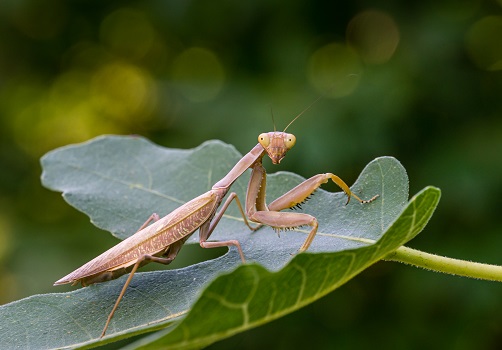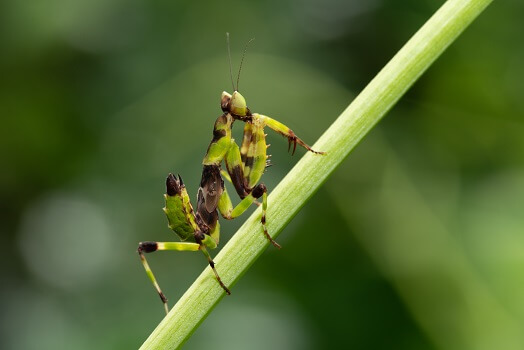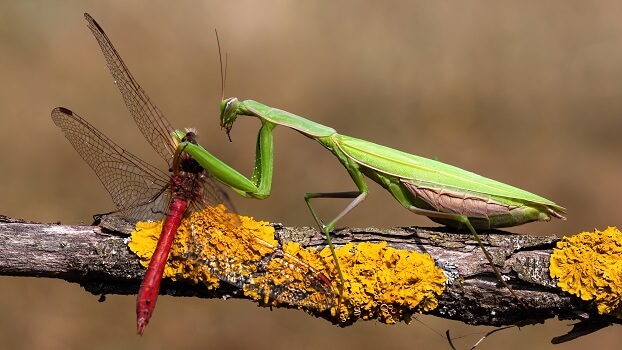
The Praying Mantis (Mantis religiosa), or European Mantis, is a species of praying mantid belonging to the family Mantidae. As its name suggests, it is native to Europe but it is also native to parts of Asia and Africa as well. This mantis species is widespread over parts of the US and Canada, although it is not native here and was introduced over a century ago. It was accidentally introduced to New York from Europe in 1899 and continues to spread, being found as far west as the Vancouver area in Canada. There are 12 recognized subspecies across its range. These insects are named for their stance which resembles someone praying. Over 2,400 insects belong to the order Mantodea. People often refer to any of these insects as a praying mantis, when really they are praying mantids as they belong to a different genus. While there are 15 species belonging to the genus Mantis, the European Mantis is the one most commonly known as the praying mantis. Like all insects, the praying mantis has a segmented body, consisting of three segments – the head, thorax, and abdomen. In adults, the abdomen is covered by wings. They have four legs at the abdomen area and another two larger forelegs that appear to be more like arms. Their head is triangular in shape and contains their large, compound eyes. A praying mantis can rotate its head 180 degrees, as well as pivot it, giving it an excellent range of vision. They also have antennae which are used for smell. Like all mantids, the praying mantis is sexually dimorphic with the females being larger than the males. These insects are found in a variety of habitats, ranging from valleys to urban gardens. They prefer warm, natural habitats that have long grass and various other shrubs and bushes. These wild areas are more likely to be home to an abundance of prey for the praying mantis to feed on. The adults can survive high temperatures and so it is not uncommon to find them in semi-arid desert regions. The European mantis is a notorious predator and feeds on a wide range of insects, like most of the mantid species. Some of its larger relatives are known to eat small reptiles, birds, and even some small mammals! These insects use their camouflage to blend in with their environment, where they wait until their prey is in striking distance and then they ambush it. It uses its lightening-fast front legs (raptorial legs) to quickly snare its victim. It takes the praying mantis only 50 – 70 milliseconds to strike out with its forelegs and grasp its prey. Their front legs have rows of spines that help them to keep hold of their prey while they consume it, usually head first! The praying mantis has powerful mouthparts – called mandibles – that help it to devour its prey. As the praying mantis doesn’t have a long lifespan, they only mate once and this usually takes place in the autumn, or fall, months. After the male and female have mated, the female will produce an ootheca – an egg mass that contains proteins and tanning agents that provide protection by encasing the eggs. This ootheca will contain between 100 and 200 eggs. The eggs develop over the winter months and the larvae hatch in the spring. The larvae will then undergo several molts, with the first happening shortly after hatch. Unfortunately, very few praying mantis nymphs survive the first instar stage due to a lack of food and low temperatures. The man predators of the praying mantis include monkeys, bats, frogs, birds, spiders, and snakes. The praying mantis will even eat its own kind, especially during the nymph stage and during mating. When threatened by a predator, this insect will stand up on its back legs, with its raptorial legs raised over its head to make it seem bigger than it is. It will also beat its wings. The praying mantis is a fascinating insect! Native to Europe, Africa, and Asia this insect is now found across the US and is even the state insect of Connecticut! Known for eliminating pests on farms as well as its famous prayer-like stance, this insect has some amazing biological adaptations that help it survive in a variety of habitats. Let’s take a closer look! The sexual behavior of the praying mantids is well known, as it has received a lot of interest from scientists over the last century. In the European mantis, the males initiate contact with the females. When a sexually mature male spots a sexually mature female, he begins to approach her with caution. The females are much larger than the males and there is a chance that if she spots him first she will attack and kill him. The male will approach the female cautiously from behind, stopping if she makes any sudden movements. Once the male is close enough to the female, he will jump on her back and hold onto her with his front legs. Once the male is in a secure position, then copulation is initiated. Following copulation, which can take four to five hours, the male lets go of the female and quickly drops to the ground so that he is far enough away from the female to feel safe. Sometimes, however, the male is attacked and eaten after, during, or on rare occasions before, copulation. This is called sexual cannibalism. There are some benefits that the female can gain by eating her mate: 1. It provides her with nutrients so that she doesn’t have to hunt post copulation, and 2. This meal gives her more resources for faster production of large eggs which increases the chance her offspring will survive. While this doesn’t seem very beneficial for the male, males are only likely to mate once in their lifetime and so by also providing nutrients for the female by becoming her meal, the male increases the chances of his genetic material being passed on. Sexual cannibalism isn’t unique to the praying mantis! Other animals that are known to eat their mates include the black widow spider, the jumping spider, and several species of scorpion. Like all insects belonging to the order Mantidoa, the Praying Mantis has only one ear! What’s even more interesting is that this single ear is located on the underside of its belly, just forward of its hind legs. The location of its ear means that they praying mantis is unable to distinguish which direction a sound is coming from. However, the praying mantis ear can detect ultrasound, which is produced by echolocating bats. This helps them to evade any bats that are on the hunt. The praying mantis has even been known to stop and drop to the ground mid-flight if it hears a bat coming. Although the European Mantis is not native to Connecticut, it became the State Insect on October 1, 1977. This insect is found throughout the state from early May or June until the cold weather arrives and they begin to die rapidly. This small green or brown mantis species is very beneficial to farmers as it eats several other insects that can be destructive to crops, including aphids and small caterpillars. Aside from being a State Insect, the praying mantis also makes a popular pet!
Kingdom
Animalia
Phylum
Arthropoda
Class
Insecta
Order
Mantodea
Family
Mantidae
Genus
Mantis
Species
Mantis religiosa
Niche
Carnivorous
Length
1.95 in – 2.93 in (50 mm – 70 mm)
Weight
0.14 – 0.18 ounces (4 – 5 grams)
Lifespan
1 year in the wild
Social Structure
Solitary
Conservation Status
Least Concern
Preferred Habitat
Varied; prefer sunny areas with lots of vegetation
Average clutch Size
100 eggs
Main Prey Species
Other insects such as flies, crickets, beetles, moths, and bees
Predators
Frogs, bats, monkeys, larger birds, spiders, and snakes
The Basics

Fun Facts about the Praying Mantis!
Female Mantis Eats Her Mate

The Praying Mantis Has Only One Ear

Connecticut’s State Insect!
